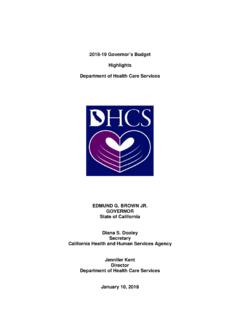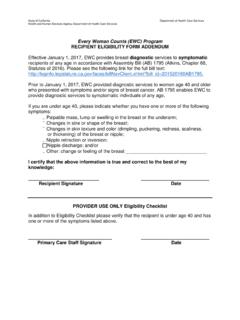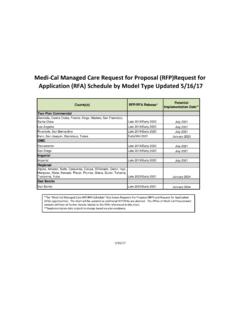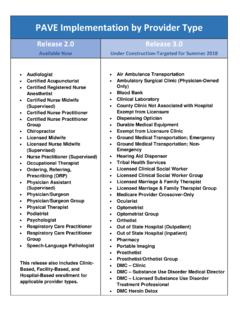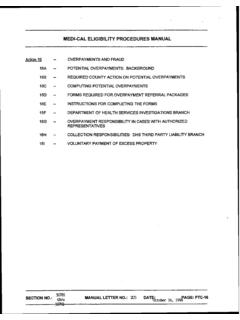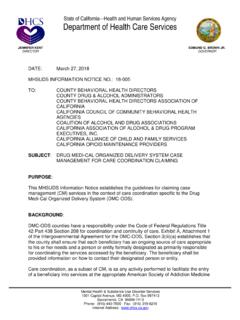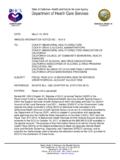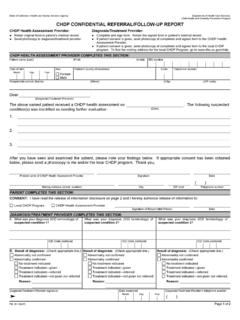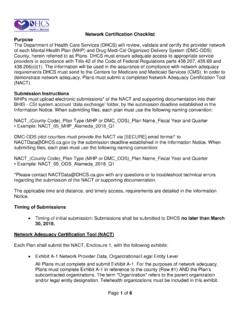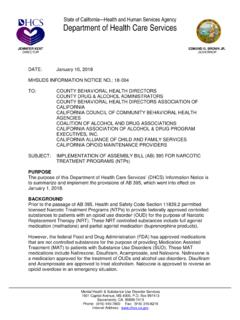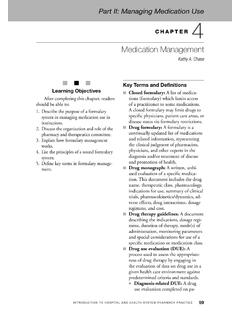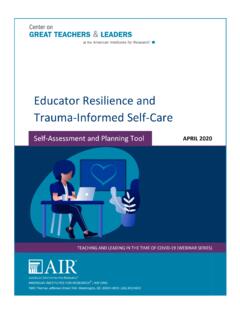Transcription of The Pediatric ACEs and Related Life-events ... - California
1 ThePediatric ACEs andRelatedLife-eventsScreener(PEARLS) FrequentlyAskedQuestions(FAQs) The Pediatric ACEs and Related Life-events Screener (PEARLS) was developed by the Bay Area Research Consortium on Toxic Stress and Health (BARC), a partnership between the Center for Youth Wellness, UCSF Benioff Children s Oakland, and the Adversity Bio-Core (ABC) Bank at the UCSF School of Medicine and Pharmacy. The tool was designed to identify exposure to childhood adversity and events that may increase a child s risk for toxic stress and negative health outcomes. The tool is currently available, free of charge, and is recommended for use in all child-serving medical practice settings. What does the PEARLS tool screen for? The PEARLS screens for a child s exposure to Adverse Childhood Experiences (ACEs) and other potential risk factors for toxic stress (bullying, community violence, food or housing insecurity, etc.)
2 That may increase a child s risk for negative health outcomes. These exposures were selected because they have been linked with poor physical, developmental, and behavioral health outcomesin childhood andthroughout life. The PEARLS has two sections:Section 1 screens for the ACEs tied to lifelong health and wellness challenges in the original Felitti and Anda research on ACEs1. Section 2 includes other risk factors for toxic stress not in the original ACE Study, but which have also been found to impact child and adult health. Their potential pathways to affecting health are being investigated in an ongoing BARC study, which actually shares the name PEARLS (although the study s R stands for Resilience because of the study s interventions). The tool s name thus pays homage to its ground-breaking origins. The PEARLS asks whether an individual has ever experienced: Section 1. Adverse Childhood Experiences (ACEs) Abuse (physical, emotional, sexual) Neglect (physical, emotional) Dysfunction in the household among parents/caregivers (caregiver separation/divorce, domestic violence, substance misuse, incarceration, mental illness) Section 2.
3 Other risk factors for toxic stress not included in the ACE study Hardship (food insecurity, housing instability) Others significant life events (caregiver s serious physical illness or death, community violence, bullying, discrimination) How wasthePEARLS developed? ThePEARLS toolwas developedaspart oftheBARCP ediatric ACEsScreeningandResilienceStudy,a partnershipbetweentheCenterforYouthWelln ess,UCSFB enioffChildren s Oakland,andtheAdversity Bio-Core(ABC)Bank attheUCSFS choolofMedicine s questions were selectedthrough arigorous scientific process involving aliteraturereviewand scanforexistingACEs andtrauma screening tools,andexpertopinion done attheCenterfor Youth Wellness ontheCYWA dverseChildhoodExperiences Questionnaire(CYWACE-Q). The PEARLS tool adaptedthe CYWACE-Q,thenpilotedanditeratively changeditbased onpediatrician,parent, andcaregiver initiallevelofvalidation canbefoundin this peer-reviewed article.
4 Given the BARC s intentional, rigorous, andevolutionary validation process, CYW now recommends that all clinicians usethePEARLSin placeoftheCYWACE-Q. 1 Felitti and Anda (1998)ACE Study Where can I find the PEARLS tool and what versions are available? The PEARLS can be downloaded from theNational Pediatric Practice Community on ACEs (NPPC)website. To download PEARLS, you will need to become an NPPC member (click Join on the website). There are multiple versions based on the child s age, including parent/caregiver versions for children and adolescents and teen self-reporting, the primary language needed, and whether the person answering is asked to specify which experience(s) happened or simply share a total number. Age and Reporter Child P/C: Parent or caregiver reports on a child s (ages 0-11) experience; includes 17 questions Teen P/C: Parent or caregiver reports on a teen s (ages 12-19) experience; includes 19 questions Teen SR: Teen (ages 12-19) self-reports on his or her own experiences; includes 19 questions Formats De-identified : Respondents simply count the number of experiences from a list of what could have happened to their child or themselves, and write down the total number that happened (they do not specify which adverse experience happened).
5 This version is a quick assessment of risk for toxic stress intended for use in a busy Pediatric practice and with the assumption that further assessment or identification of the items will occur with follow up or referral Identified : Respondents specify which experience(s) happened to their child or themselves (if using the self-report version) by choosing yes or no for each question. It provides the provider with specific information about which experiences their patient has encountered. Practices seeking information about which version(s) and format(s) may best fit their providers and patients can read more on the NPPC websiteor contact the NPPC team. Is the PEARLS validated? The PEARLS Child P/C has been found to have high face validity. This means it s highly likely the items on the tool are measuring actual exposure to ACEs and Related Life-events among children, even though humans (as opposed to other information sources) are reporting.
6 This phase of validation included cognitive interview and item wording refinement with parents/caregivers, physicians and clinic staff, as outlined in the BARC manuscript published in December 2018 on PLOS One. The tool continues to be understood as part of an ongoing randomized, controlled trial (of the same name). The study s investigators believe they will soon be able to further validate the PEARLS based on children s health outcomes and biological markers of toxic stress. PEARLS Teen P/C and PEARLS Teen SR are not currently part of the ongoing study and are therefore not currently receiving the same level of validation testing. However, the questions on these versions for teenagers are identical to those on the child version, except the teen versions include an additional 2 questions identified as important by community-based participatory research with youth in San Francisco2. The additional teen items areintimate partner violence and bullying experienced by the teen, which have been found to impact health.
7 These items have been tested clinically as part of the CYW ACE-Q tools for parents and caregivers reporting on their teens experiences and teens reporting for themselves. 2 Purewal Boparai, Sukhdip; Marie, Tiffani; Aguayo, Eduardo; Brooks, Jordan; Juarez, Estefany; Soriano, Sheana; Waters, Alasia; Donaldson, Jaquez; Reagans, Joseph; Anguiano, Gracee; and Ipsen, Allison (2017) "Adversity and academic performance among adolescent youth: a community-based participatory research study," Journal of Adolescent and Family Health: Vol. 8 : Iss. 1 , Article 2. Where can I get more information or training on how to use the PEARLS? This tool was made publicly available for use as of its first peer-reviewed journal article published December 12, 2018. For more detailed information about how to use the tool or for training assistance, please contact the CYW NPPC: National Pediatric Practice Community on ACEs (NPPC) Center for Youth Wellness 329 Evans Avenue San Francisco, CA 94124-1705 (415) 684-9520
